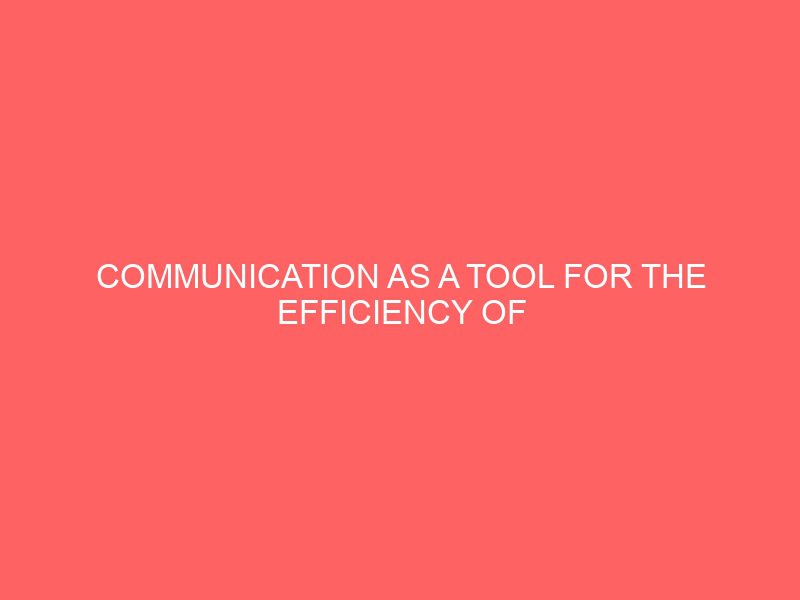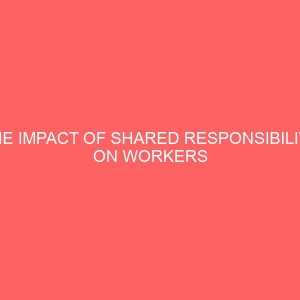Description
Abstract
This research focuses on communication as a tool for the efficiency of workers’ performance in an organization. Based on the analysis of the data collected, the following findings were made; that communication skill is very important in assessing the success of an employee in the organization. The communication system that exists between management and the subordinate is both the formal and informal system. Based on the above findings, the following recommendations were made for implementation. The management should ensure that the information they send down the line always get to the target audience. The company should make sure that all external relationship with the outside world is maintained. The subordinate should be given adequate information concerning the company’s policies, decision, practices and benefits so as to boost their morale.
TABLE OF CONTENTS
Title Page i
Certification ii
Dedication iii
Acknowledgments iv
Abstract v
Table of Contents vi
CHAPTER ONE
1.1 Introduction1
1.2 Meaning 3
1.3 Statement of Research Problem 4
1.4 Objectives of the Study 5
1.5 Scope of Study 5
1.6 Limitations of the Study 6
1.7 Definitions of Terms 6
CHAPTER TWO: LITERATURE REVIEW 7
The Concept of Communication 8
What is Communication 9
Types of Organizational Communication 9
The Formal Communication 10
The Informal Communication 10
Upward Communication 11
CHAPTER THREE: DISCUSSION 13
Horizontal Communication 13
Crosswise Communication 13
The Benefits of Communication in the Organization 14
Problems and Barriers to Effective Communication in
an Organization 15
CHAPTER FOUR: SUMMARY OF FINDING, CONCLUSION AND
RECOMMENDATIONS 18
Summary of Findings 18
Conclusion 19
Recommendations 20
References 22
CHAPTER ONE
BACKGROUND OF THE STUDY COMMUNICATION
INTRODUCTION
Communication has always been an important feature of life. All human beings engage in communication to sustain and improve on their existence on earth. Communication being the nerve centre of the society cuts across cultures. There is no society where communication does not exist. It is the basis for all human existence. We find ourselves either consciously or unconsciously faced with-the urge to give or receive information, express our feelings, share ideals with others. Research findings have shown that the average human. Being spends no less than 80% of his life engaged in one form of communication or another every day. Communication is therefore a social affair. It is the means by which man can function within a social framework since it is not possible for human being to exist in isolation from others.
The term communication is derived from a Latin word ‘Communis’ which means commonness i.e. to share to make common. In communication what is shared is not seen but virtually abstract. It is psychological activity and it has to do with the mind building a bridge between or across two minds. Meaning is what we have in common in the sense that the symbols that are used in encoding the message must be understood by the interlocutors. In other words, for a particular message to be meaningful, there has to be ‘mental connectivity’ between the encoder(s) and the decoder(s) of that message when what we say is correctly or fully understood by our listener, we say there is effective communication.
Therefore, communication is effective when the speaker and the listener share the same meaning. Communication breakdown on the other hand occurs when the listener misinterprets or gets a different meaning from that intended by the speaker.
The ubiquitous of combination technical devices like the fax, telephone, radio, computer internet etc have further enhanced and consolidated the relevance of communication in the society. All these various device have tremendous impact in making communication between individuals and people as easy and convenient world and as fast as possible. The world has become a global village as we now say, because of the free access everyone has to information from any part of the world.
MEANING
As important as communication is, scholars have defined it from different perspectives inspired by their different professions. Some of such definitions are given below.
According to Chappell and Reed (1974), “communication is any means by which a thought is transferred from one person to another”. In the opinion of Eyre in Sybil et al (1995) “communication is not just the giving of information, it is the giving of understandable information and receiving and understanding of the message”, it is the transferring of a message to another party so that it can be understood and acted upon.
In the words of Cooky, he described communication as “a mechanism by which human relations exists and develop”.
Peter Little (1985) defines communication to be “the process by which information is passed between individual and/or organizations by means of previously agreed symbols.
In essence, going through all that have been said, they all point at the same facts. One can summarily say that communication is:
(i) A process of sending and receiving information
(ii) The sharing and imparting of information
(iii) The giving of understandable information and the living of and understanding of the message.
(iv) The conveying of ideas, feelings and attitudes
(v) The transmission of message and linking of people.
(vi) That communication involves a speaker with a message for a hearer who on interpreting the message may give a response in form of a feedback.
1.3 STATEMENT OF RESEARCH PROBLEM
This research work attempts to find solution to the following;
1) Is communication system efficient in an organization?
ii) What are the benefits of communication in an organization?
iii) Are there enough devices to effect communication in an organization?
1.4 OBJECTIVES OF THE STUDY
This research work is specially aimed at achieving the following objectives;
a) To examine the extent to which communication is effective in an organization.
b) To know the kind of communication that exists between management and subordinates.
c) To examine the advantages that is derived from business communication.
d) To know the effectiveness of communication in decision making in an organization
1.5 SCOPE OF STUDY
The scope of this study is limited to Unilever (Nigeria) Plc, Benin, Edo State.
1.6 LIMITATIONS OF THE STUDY
A research work of this nature is often hindered with some limitations. The research encountered some problems, which affects the conduct of the research work.
The problems are financial constraints and lack of time. The researcher would have carried out the research to cover the whole country or at least some states but there was no enough time and money in the course of the study.
1.7 OPERATIONAL DEFINITION OF TERMS
The following terms defined are used in the study to enhance easy understanding.
Business: This refers to any undertaking, which involves the creation and manufacturing of goods and services with a view of making profit. It also serves at satisfying human needs and wants.
Organization: This refers to a group of persons who come together to form a business, club, etc in order achieve a particular aim or goal.
Management: This refers to the procedures involved in planning organization, directing staffing, controlling of the various resources of an organizations with the aim of maximizing benefits.
Communication: This refers to the process by which information is passed through one person or group of persons to the other, through the means of previously agreed symbols.







